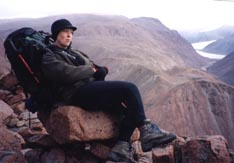Local woman hikes to the 'top of the world'
 A year ago, local resident Linda Liestman trekked to the "top of the world." She took a 15-day trip to Ellesmere Island, the northernmost Canadian island, where she spent ten days hiking around the north edge of the Prince of Wales ice field.
A year ago, local resident Linda Liestman trekked to the "top of the world." She took a 15-day trip to Ellesmere Island, the northernmost Canadian island, where she spent ten days hiking around the north edge of the Prince of Wales ice field. In the year since her trek, she has written a book based on her diary entries about her trip. In it, she describes the challenge of hiking in the Arctic and the stark beauty of the polar desert.
Linda takes some time to relax on top of the rocks before decending back down to the campsite.
Liestman heard about hiking in the arctic while descending and climbing in the Grand Canyon. Ellesmere Island is northwest of Greenland in the Arctic Circle. "I got inspired and checked out guides," she said of her interest in arctic hiking.
It took three days by plane to reach Resolute Bay, one of two year-round settlements in the Canadian Arctic, and another three hours to reach their final destination, Beitstad Fjord on the east side of Ellesmere Island.
From there, the nine hikers in the group skirted the north edge of the Prince of Wales ice field for ten days, seeing several glaciers and hiking through Sverdrup Pass.
 Liestman likes a challenge that tests her spirit, physical strength, and endurance. "A little danger only adds to the experience," she wrote in her trip diary, "and the remoteness of an area excites rather than scares me."
Liestman likes a challenge that tests her spirit, physical strength, and endurance. "A little danger only adds to the experience," she wrote in her trip diary, "and the remoteness of an area excites rather than scares me."
She planned and conditioned for the trip for two years. Hiking on Ellesmere is normally limited to an eight-week window due to the extreme weather conditions of the Arctic.
Lost Lake is where Liestman's group camped on the second day out. Several days later, the lake had totally disappeared.
Hiking days started at 11 a.m and lasted until about 6 p.m., which was considered a good day for nonelite hikers. Ellesmere in the summer has 24 hours of daylight, which Liestman found as no obstacle to sleep after a hard day of hiking.
The paths through the mountains were very rugged. Because of the permafrost, the gravel top soil was unstable. The hikers soon learned to know which rocks were safest to step on. A wrong step could cause a gravel slide bringing the whole group to the bottom of the slope.
The entire group had preconceived ideas of flatter ground in the Arctic, Liestman said. She was thankful for her experience on the steep slopes of the Grand Canyon. At one point, she grabbed a slipping hiker and saved her from a fall.
Other dangers were quicksand and river crossings. Liestman sunk into quicksand up to her knee and had to patiently work her way out, keeping her boot on her foot.
 Liestman did not look forward to river crossings. "We used our hiking poles to help steady us," she said. "I kept telling myself I had to do it. It was necessary to reach the other side," she added. The water was cold but not as numbing as she had expected. The current, though, was strong and fast.
Liestman did not look forward to river crossings. "We used our hiking poles to help steady us," she said. "I kept telling myself I had to do it. It was necessary to reach the other side," she added. The water was cold but not as numbing as she had expected. The current, though, was strong and fast.
Liestman's group climbing the Prince of Wales ice field.
The 100,000-year-old ice in the ice field was about 1,000 feet thick and flanked them the entire route of their hike. "The ice was always there with water always coming down the sides," Liestman said.
Even though the ice fields had about four inches of slush on top, the group found the fields easier to walk on than the rocky tundra.
The colors in the area were very intense, Liestman said. The blues of the water and ice were beautiful in a rugged way. She was surprised to find flowers in the tundra. Cotton balls were her favorite. These flowers appeared to look like small cotton balls in the grass.
The Arctic tundra provided little privacy for the hikers on the trek. The lack of trees provided little cover for privacy and also prevented the group from making campfires. The hikers also had to share tents.
Not only did the trekkers hike across snow and ice, snow and sleet actually fell on them during the trip. Liestman said it took her more than an hour to warm up in her sleeping bag before she could get to sleep.
Liestman had hoped to see a polar bear while on the trip, but the closest she came to one were huge paw tracks in the lake basin.
Despite all the dangers, Liestman said she would love to go back and hike in the area again. She usually plans a major hiking trip every couple years and hasn't ruled out the option of returning to the Arctic in 2002 or 2003.
Contact the author at paypress@lkdllink.net • Return to News Menu
Home | Marketplace | Community